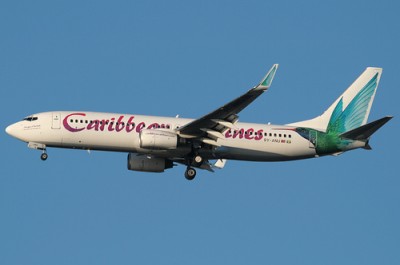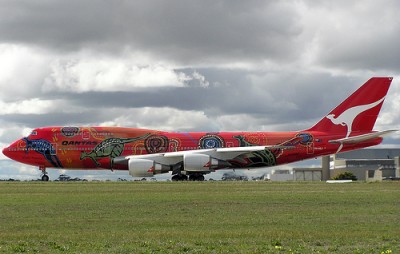
My mom love's hummingbirds and this livery delivers!
A very special Mother’s Day to my mom and all the mom’s out there. My mom has been wonderfully supportive of my blog (even writing a few blogs herself)!
THANKS MOM!

My mom love's hummingbirds and this livery delivers!
A very special Mother’s Day to my mom and all the mom’s out there. My mom has been wonderfully supportive of my blog (even writing a few blogs herself)!
THANKS MOM!

"Wunala Dreaming" is the name of this Qantas 747-400, painted with a design inspired by Aboriginal art.
Each week I do an airline livery and many times I have been given a heads up by Yvette Scott (@airlinesangel) on new liveries to take a look at. I am about to return from my vacation and have asked her to do the livery of the week today. Here is her post:
I’m very honoured that David had asked me to select the livery of the week. Each week I look forward to which airline/livery David has discovered, many are new, many are from the past, but they all have a story to tell in the great world of aviation.
The airline I’ve selected is Qantas, Australia’s largest airline and the considered to be the world’s oldest continually operating airline. Their fleet consists of over 251 aircraft, ranging from Bombardier Dash 8 to Airbus A380.
Today their livery is white fusalage with a red tail featuring the distinctive kangaroo logo. Their B747-438, in addition to their usual city names, carry the word “Longreach” as part of the livery. This signifies both the “long reach” of the aircraft and the town where Qantas began. In 1993, as part of the International Year of the World’s Indigenous People, some aircraft were named and painted aircraft with Aboriginal themes.
More photos through Airliners.net
Thanks Yvette! Be sure to also check out her blog: Airlines Angel.
Blog Image: Denmac25
The Doggie that rode next to Dani
I was reading a friend’s personal blog recently and came across a blog she wrote last December. I thought it really brings up some interesting points and wanted to share it. Here is Dani Dutro’s story in her own words:
It’s 5:30am and my alarm goes off. Less than 2 minutes later I get a phone call. The shuttle is calling to let me know that they’re early (and acting like I should give them a prize for being early before 6am!! Not cool. I hug my aunt goodbye and hop in the shuttle. We go to pick up other passengers and at one stop, I can see that the driver missed his turn on purpose because a police officer had just made the same turn in front of us and apparently I’m dealing with some kind of felon as a driver because he doesn’t want to be anywhere near an officer ’“ greeeeaaaat.
Finally, we arrive safely at LAX. I’m already checked in and sail through the TSA line. This officer actually flirts with me and this is the only time I have ever gone through airport security and remained in a good mood.
Now I have time for coffee and a little reflection upon my awesome trip to the Evolution of Psychotherapy Conference’¦
And then we begin the boarding process’¦
As I’m walking down the ramp I notice this woman in an argument with the gate agent. The woman has about 6 carryon bags (including a guitar in a hard case and a black dog on a leash wearing a service animal jacket). The woman is upset because the agent is telling her they may not be able to get her guitar into the first class closet and it may need to be checked. I was thinking to myself that both women should calm down ’“ the one with all the carryon should have been at the gate earlier and the agent should really just learn to be NICE!
I sit down and stow all my luggage (a modest duffel and my backpack/bookbag) and then I notice that the woman with the carryon & the dog are definitely going to sit with me. She’s bumping into literally everyone as she goes down the aisle with her carryon, dog, and not small self (only 9 rows back) and now I’m a little annoyed. She is calling a lot of attention to herself and her dog is clearly a poorly-trained ’œemotional support animal’ and I’m starting to feel a little of the gate agent’s pain on this one. Finally she sits down and the dog squeezes into the floor space between us.
Moments later a man walks to the edge of our aisle and is visibly annoyed because he sees my seatmate literally spilling into his seat and then he notices the dog where his feet are supposed to be. The woman is not exactly accommodating to him or the flight attendants and made a comment about how it was the flight attendant’s job to fix the situation and she was not particularly interested in taking up her ’œfair’ share of the seat. The gentleman moved on quite quickly and the flight attendant apparently did reseat him.
The woman settles in, and before the door is closed she hits me with, ’œI’m sorry I’m such a pain but I’m heading to my father’s funeral.’ Who’s the asshole now, D’½
So, we talked, she cried, I did some good while on the plane’¦ Taught me a lot about how to take a minute and have empathy wherever I am. It was a great lesson especially since I had just spent 4 amazing days at a conference renewing my passion for counseling ’“ how fitting that a woman in need of some brief grief counseling would end up sitting next to me on the plane (with her sweet doggie)!
When I was a young kid I remember seeing this commercial on TV. With all the talk about all these extra fees and maybe having to pay for bathrooms, I couldn’t help but think of this classic commercial. Thanks to YouTube, I was able to track it down and wanted to share. Little did the ad agency know how real this might become.
This also shows that is Ryanair will really do this (I don’t think they will), they need to make sure the doors take credit cards!
These are some of my favorite things: Boeing, Paine Field, Future of Flight, General Aviation and free stuff.
Where can you get all of these in one shot? At the General Aviation Day!
Details:
WHAT: General Aviation Day
WHEN: Saturday, May 15th 2010 9am to 3:30pm
WHERE: Paine Field @ 3601 109th Street Southwest Everett, WA 98204
HOW MUCH: $0 – Admission is FREE!
So what’s gonna be there you ask?
* Flying Heritage Collection
* Historic Flight Foundation Open House
* Cascade War Birds
* FOOD! Taste of Mukilteo + Kiwanis BBQ
* Activities for kids
* Future of Flight
* Free Young Eagle Flights (for kids 8-17)
* Learn to fly seminar for adults
* Oh yea, AIRPLANES!
* AND MUCH MORE
You better believe there is gonna be some sort of Tweet Up going on at the event as well. No need to register just show up. And if you are going to show up, be sure to Tweet so we can meet up!